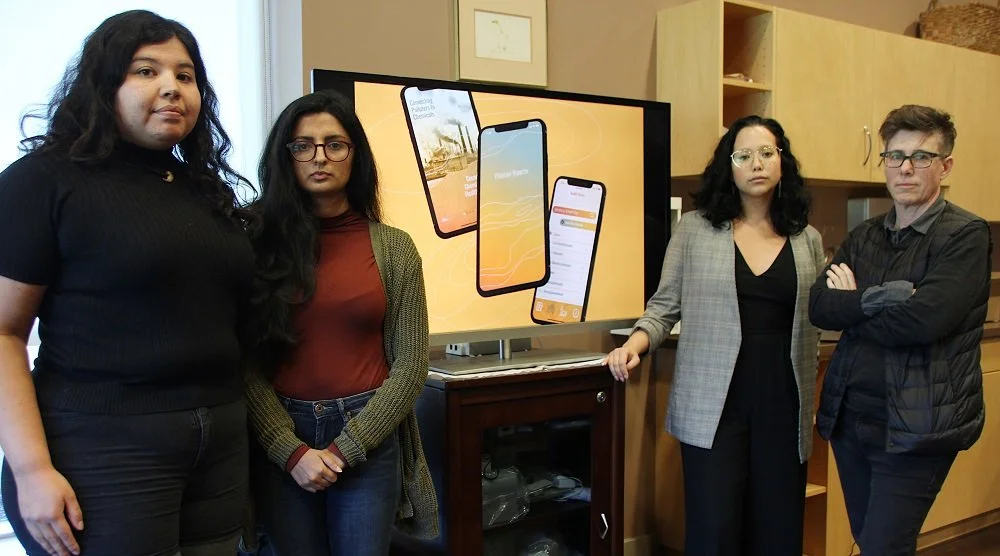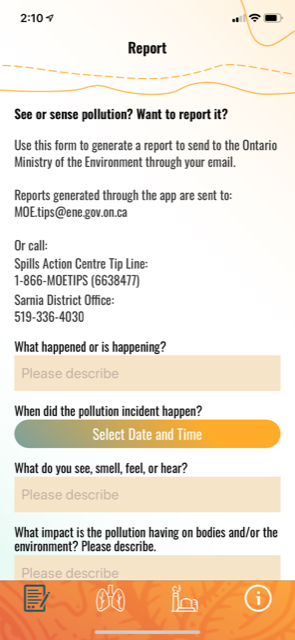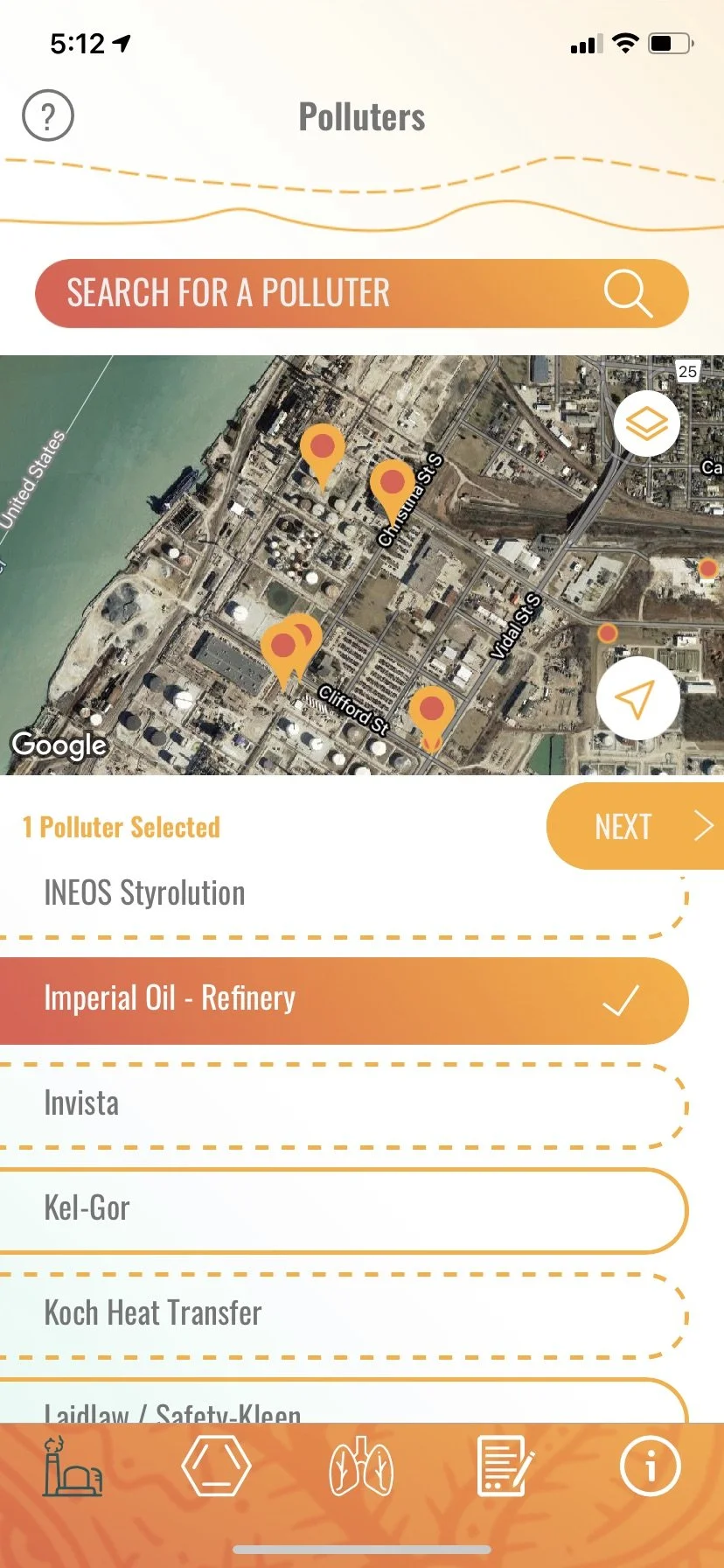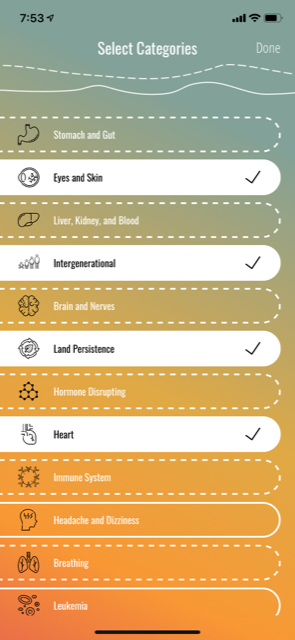Pollution Reporter
The Pollution Reporter Mobile App Version 2.0 is focused on Ontario's Chemical Valley, where some 40% of Canada's petrochemicals are processed, and that is on traditional Anishinaabek territory, and particularly the land of Aamjiwnaang First Nation.
Download the latest version in the Apple App Store or Google Play.
This app has TWO uses.
ONE: Use Pollution Reporter to get accessible information about pollution from the refineries and other industrial facilities in Chemical Valley. The app shares information that connects polluters to their pollution to research on known health harms.
TWO: Use Pollution Reporter to report a pollution event, spill, or leak to the Ontario Ministry of Environment, making it easier for community members to report problems to the Spill Action Centre. The app assists in making the report, which is then sent through the users own email, and allows users to share on social media or keep a record of their reports.
Pollution Reporter is primarily intended for the use of the Aamjiwnaang First Nation community and others who live near Chemical Valley, but anyone is welcome to use the app to better understand the health harms associated with pollutants.
How Does The App Connect Pollution to Health Harms?
The Pollution Reporter App translates and connects government, industry-reported, and peer reviewed sources of data into accessible information about the known health effects of pollutants. You can search by polluter, by chemical pollutant or by health category or symptom. By providing this information, the app assists in attaching responsibility for health harms to chemicals and the corporations that make them. As well, the app connects to information about the cumulative rates of pollution for each chemical pollutant. As a whole, this information provides testimony about the permission-to-pollute system of Canadian governance, which is designed to let environmental harms occur up to a certain level on a chemical by chemical basis, but does not adequately consider the cumulative and long term effects of pollution.
The health information provided in the app is not a medical diagnosis, but it does summarize in an accessible way the peer-reviewed medical research about associations between pollutants and health effects.
Pollution Reporter hopes to support community member's abilities to link health harms to companies and pollution without having to demonstrate their own health harms and be subjected to extractive research.
In respect of Indigenous Data Sovereignty, Pollution Reporter does not collect data about its users, and users are in full control of their reports to the Ministry of Environment.
Elder Mike Plain on the App
"My way of thinking about it is even if one or two people call, that is enough for concern, It is just as much of a concern if 20 or 100 people call because “we are talking about life”, we are speaking about the animals, birds and fish life, were talking about air life, ground life, all these things that can’t call in or make reports. A bird can’t make a report. A squirrel and a raccoon can’t call in to complain even though they are also being affected during a spill. We as human beings have to call in or make reports for those who can’t. We have to be their voice. We shouldn’t have to say we're speaking up for the fish, birds and butterflies, we shouldn’t have to say that because automatically our complaint is for them too, our voice is for them too. So that could be 10-20 birds with our call. It's not just human beings, the Canadian government is so egotistical to say that human beings are the only ones that suffer, but we're not, everything else suffers too. This app is for them too, this app is for those birds and bees and everything. So when we made a report we were speaking for them too. But when two people call in, the government dismisses the incident because only two people call in to complain, but those two people might be affected and die in the next few years from cancer or something. What's the difference between those two and 100 calls, those 2 people could die from toxins."
About the Data
Pollution Reporter uses government-collected chemical emissions data from the National Pollution Release Inventory, in which companies admit to polluting from a list of 300 chemicals. The app connects that data to peer-reviewed research about the health injuries associated with each chemical pollutant. To connect facility chemical emissions data to their health effects, we consulted peer reviewed studies, occupational health and safety literature, government environmental and human health datasets, as well as a set of publicly available toxicological databases from Canada, the United States, and the World Health Organization.
Limits and Uses of the Data
This app uses inadequate data about pollution emissions and connects it to health harms information using more accessible language.
These connections show a polluter's responsibilities for putting health harms into the world.
Health Harm Research
Some chemicals have decades of health research, other chemicals very little.
We identify health harms as “strong evidence” if there are multiple studies (either human or animal-based) with strong evidence.
We identify health harms as “some evidence” if there is some evidence of harm but it is not yet conclusive, or there are only few studies available.
Government data about pollution does not connect polluters to chemicals and their health harms.
Government data about pollution is:
Created by Industry. Most emissions data are self-reported by the industries that are doing the polluting.
Disconnected. Information on pollution and information on health harms exist in separate databases and require extensive research to put together.
Hard to Get. Most information is not accessible to the public. It is expressed in technical language and held in private, paid, or subscription-based sources.
Inaccurate. Governments and industry tend to underreport harms, especially on hormone disruption and the health harms of low-level exposures.
Out of Date. Government reviews of health harms can be decades out of date.
One at a Time. Information about pollutants and health harms are usually organized one chemical at a time. We live in places with many chemical exposures happening at the same time, and adding up over time.
Our Research
This app draws on a variety of information sources, as well as consults current peer-reviewed health research.
We translate this research into accessible language.
Sources on Pollution:
National Pollution Release Inventory (NPRI)
Industries self-report their pollution to the Canadian government annually. The NPRI is useful because specific facilities and companies admit to their pollution.
But the NPRI is flawed:
The amounts reported are usually only estimates, which means the actual emissions are not measured.
Chemicals are listed one-by-one.
The accumulation of pollution to air, land, and water over time is ignored.
PubChem
This source provides technical information about chemicals, primarily directed at engineers, scientists, and industrial users.
Sources on Health Harms
The app uses and evaluates peer reviewed medical research. It uses this research to provide accessible information about health harms that a chemical pollutant may cause or is correlated with. The information is not a medical diagnosis. It does suggest, however, that polluters and their pollutants are responsible for possible health harms.
TOXNET
TOXNET is a US government website that compiles peer-reviewed health information on chemicals. Government datasets like TOXNET often do not include the latest research on health harms related to low-level effects, hormonal disruption, intergenerational effects, persistence in land or bodies, as well as other felt ways that chemicals can affect daily life that are not a disease, like a headache (which are called subclinical effects).
TedX
TEDX is a science-based, nonprofit research institute that provides information about the production and use of chemicals that interfere with healthy hormone function. TEDX uses systematic review methods developed by the US National Toxicology Program to identify hormone disrupting chemicals.
IARC
The International Agency for Research on Cancer is the specialized cancer agency of the World Health Organization. It uses systematic review methods to identify cancer-causing chemicals.
Proposition 65 Cancer List
California’s Proposition 65 is a law that requires the publication of a list of chemicals that may cause cancer or reproductive harm. This list is updated yearly.
About the Project
The Pollution Reporter App is being made by the Environmental Data Justice Lab at the Technoscience Research Unit, University of Toronto. This is an Indigenous-led lab composed of university and community researchers, in collaboration with the City as Platform Lab and Reflekor developers. The App team is composed of Michelle Murphy, Vanessa Gray, Reena Shadaan, and Kristen Bos, with contributions in version 1.0 from Ladan Said and Beth Coleman. The making of this app has been funded by a SSHRC Insight Grant and a Connaught Global Challenge Award. The app is being developed in consultation and with guidance from the Aamjiwnaang Environmental Community and a community review process. We recognize the contributions of Tajdeep Brar , Nicholas Shapiro, Emily Simmonds, Sophie Jaworski, Jessica Caporosso in assisting with the first iteration of the dataset. We recognize the contributions of Garance Malivel, Reka Gal, Salina Suri, Sophie Jaworski, Salina Suri, Kira Lussier, Aadita Chaudury, Lindsay Leblanc, Rohini Patel, Subhanya Sivajothy, Mia McKie to our Version 2.0 data set. We also thank Dylan Miner for artwork and Lindsay Leblanc for contributions to app images.
The app is currently available as Version 2.0 for download onto phones or ipads via Google Play or Apple Store.
The Pollution Reporter software will be available free online with an open source GNU GPL 3.0 license via Github.
Questions, suggestions, or concerns about the app should be directed to technoscienceresearchunit@gmail.com.
Privacy Policy
The Technoscience Research Unit built the Pollution Reporter app as an Open Source app. This APP is provided by Technoscience Research Unit at no cost and is intended for use as is.
This page is used to inform visitors regarding our policies with the collection, use, and disclosure of Personal Information if anyone decided to use the App.
If you choose to use the app, then you agree to the use of information in relation to this policy. This app does not collect personal information and no logon is necessary. Users who send pollution incident reports using the app form will be sending the report through their own email. Users may choose to send a copy of their email to the Technoscience Research Unit. This information will only be used to improve the App service, and data collected from such reports will be made anonymous, stored securely, and the statistics from cumulative reports will be shared back to the Aamjiwnaang Environmental Committee and community. We will not use or share your information with anyone except as described in this Privacy Policy.
The terms used in this Privacy Policy have the same meanings as in our Terms and Conditions (definition), which is accessible at Pollution Reporter unless otherwise defined in this Privacy Policy.
Information Collection and Use
This app collects no user information. You may send the Technoscience Research Unit comments by email. The information you send by email will be retained by us and used as described in this privacy policy.
Log Data
We want to inform you that whenever you use our App, in a case of an error in the app we collect data and information (through third party products) on your phone called Log Data. This Log Data may include information such as your device Internet Protocol (“IP”) address, device name, operating system version, the configuration of the app when utilizing it, the time and date of your use of the Service, and other statistics.
Links to Other Sites
This App may contain links to other sites. If you click on a third-party link, you will be directed to that site. Note that these external sites are not operated by us. Therefore, we strongly advise you to review the Privacy Policy of these websites. We have no control over and assume no responsibility for the content, privacy policies, or practices of any third-party sites or services.
Children’s Privacy
These Services do not address anyone under the age of 13. We do not knowingly collect personally identifiable information from children under 13. In the case we discover that a child under 13 has provided us with personal information, we immediately delete this from our servers. If you are a parent or guardian and you are aware that your child has provided us with personal information, please contact us so that we will be able to do necessary actions.
Location Data
Users can choose to share their location with the App in order to have the map function locate around their current position. Sharing location is not a requirement of using the App. We do not save information about location sharing of users.
Changes to This Privacy Policy
We may update our Privacy Policy from time to time. Thus, you are advised to review this page periodically for any changes. We will notify you of any changes by posting the new Privacy Policy on this page. These changes are effective immediately after they are posted on this page.
Contact Us
If you have any questions or suggestions about our Privacy Policy, do not hesitate to contact us at technoscienceresearchunit@gmail.com.




